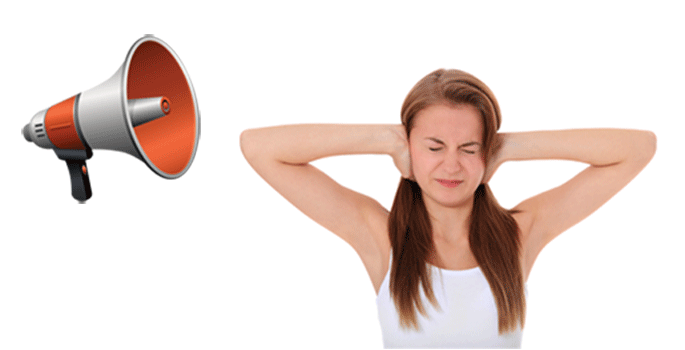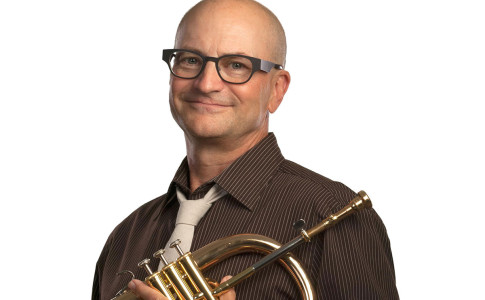Marching band is hurting your ears! Playing the cymbals has the same noise intensity as an ambulance siren while playing the flute can seem as loud as operating a chainsaw. Now imagine the combination of instruments in a full ensemble, and you’ll realize the potential damage it can do to your hearing. Protect yourselves!
When I marched in my high school band, I did not wear earplugs. As a band, we were not educated about the amount of sound and noise we were being exposed to on a daily basis. I played the flute during marching season and the bassoon during concert season. Most people think that woodwinds don’t need to worry when it comes to hearing loss; it’s just something drummers need to worry about, right? Wrong.
A clarinet clocks in at 93 dBA, and an alto sax comes in at 110 dBA—both at extremely high levels of noise exposure. However, if someone told me then that I needed to protect my hearing and that I should wear earplugs, I am not sure I would have done it. Wearing earplugs when I was marching came with a certain stigma.
Now, as hearing loss prevention is becoming more prevalent, thanks to such programs as Adopt-A-Band, more marching participants are wearing earplugs in practice and performance.
The Stats
As with many dangers, kids and young adults think that they are invincible. They choose not to floss, skip the sunscreen and do not wear seatbelts because they are young, healthy, and “it won’t happen to them.”
Like with gum disease and skin cancer, though, hearing loss is cumulative with effects seen over time. “50% of professional musicians have hearing loss,” says Brendan J. Leonard, president of Health Enterprises, Inc. “26% of high school [senior musicians] have hearing loss to some degree.”
In the whitepaper “Noise Exposure: Explanation of OSHA and NIOSH Safe‑Exposure Limits and the Importance of Noise Dosimetry,” audiologist Patricia A. Niquette explains that “OSHA permits exposures of 85 dBA for 16 hours per day, and uses a 5 dB time‑intensity tradeoff. For every 5 dB increase in noise level, the allowable exposure time is reduced by half. For every 5 dB decrease in noise level, the allowable exposure time is doubled … NIOSH recommends an exposure limit of 85 dBA for 8 hours per day, and uses a 3 dB time‑intensity tradeoff. For every 3 dB increase in noise level, the allowable exposure time is reduced by half. For every 3 dB decrease in noise level, the allowable exposure time is doubled.”
Both OSHA and NIOSH govern workplace safety, but they don’t regulate marching bands. Taking their regulations into account, though, music rooms are well over 85 dBA, so even if you are a parent observing practice, you are being exposed to extremely high levels of sound.
“A small music room with a marching band [in it] can be louder than a rock concert,” says Carolynn Travis, global brand advocate for Etymotic Research, Inc., makers of the ETY-Plugs. “The human ear overloads at 100 dBA—you cannot physically hear everything [at that level].”
Think about it this way: The unprotected permissible exposure time for playing a clarinet at 94 dBA is about an hour. For a bass drum at the low end of 100 dBA, a safe limit is only 15 minutes. When using earplugs, the exposure time is increased. For a correlation between exposure time and earplug use, visit www.etymotic-media.com/sliderule.
A study titled “How Loud is a Drum and Bugle Corps?” conducted by Dr. Sandra Teglas and Dr. Debbie O’Connell from the Music Research Institute (MRi) at The University of North Carolina at Greensboro confirmed the dangers of intense sound levels in the marching activity. Thirty members, ages 15 to 60 years old, of Carolina Gold Drum and Bugle Corps volunteered to wear sound dosimeters on their shoulders or hats during rehearsal. The sound dosimeters measured a daily sound dose, providing one-minute averages as well as all-day averages. A daily sound dose of 100% can be thought of as a daily allowance of sound.
“All instrument averages experienced sound doses exceeding NIOSH recommendations during a 12-hour rehearsal,” the study found. “Individually, all but one participant (contrabass) experienced sound doses exceeding NIOSH recommendations during a 12-hour rehearsal. Overall, battery percussion experienced the greatest sound levels, followed by pit percussion and brass. … Mellophones experienced an average of four days’ worth of sound, and the snare drums experienced an average of 49 days’ worth of sound.”
The Potential Damages
At age 66, snare drummer John Day says he “isn’t old enough” for hearing aids. “[My hearing] can’t get any worse,” he says. “I’m not at the levels of exposure that I used to be,” muses Day, who’s been playing about 57 years.
Day got his ears checked about 10 years ago after experiencing constant ringing (tinnitus) in his ears during his 40’s. Not only is Day a drummer, he was an instructor for 35 years and put himself right in the hearing danger zone as a judge for 15 years.
He and his alumni buddies from the Skyliners Drum and Bugle Corps joke that, “We’re already deaf enough—we had no idea what we were doing to ourselves.”
Day was probably unaware that if he was playing his snare for about 12 hours in a single day, he was receiving 8,822.29% of his daily noise and sound exposure.
Hearing problems can occur way faster than Day experienced. Travis says she has talked to kids in junior high, high school and college who have already experienced ringing in the ears, one of the first signs of hearing loss and an indicator of a not-so-temporary problem.
Haili Sun played the cymbals for five years and marched in the University of Southern California (USC) Trojan Marching Band. Sun said he didn’t “wear earplugs at first because you just don’t know.”
He believes that “the cymbals are the worst … 15 to 20 minutes of practice [without earplugs gets] your ears ringing.”
Ringing in the ears signifies a temporary threshold shift, but since hearing loss happens gradually, typically people do not find out that they have hearing loss until it’s too late. Unfortunately, hearing loss is not curable; there’s no magic pill, shot or procedure.
Had he known what was happening to his hearing, Day says he “wishes [he] would have thought of that 50 years ago.”
So he has a new philosophy: “Protect your eardrums, protect your body, make sure you floss everyday.”
The Solution
For hearing protection, prevention is worth more than a pound of cure—it is the cure. Specialized musicians’ earplugs help reduce noise exposure while allowing performers to hear instructions from the director and to hear themselves and others play.
Etymotic’s ETY-Plugs reduce sound evenly across frequencies (loud, moderate and soft) by approximately 20 dB. Therefore, you will still be able to hear sounds clearly, only quieter, and without muffling.
Earplugs from Health Enterprises, Inc. have continuous noise impact reducing technology that allows for 100 dBA to come in at under 85 dBA; musicians can still hear spoken instructions when using the earplugs.
“This is a tremendous opportunity to further music education,” Leonard says. “[With this technology,] we can extend the gift of music during a young musician’s formative years.” Leonard says.
Teglas and O’Connell’s paper recommends that percussionists have even greater protection.
“Custom or foam earplugs would best protect battery percussionists,” the study says. “Foam earplugs have a noise reduction rating of 29 dB. These earplugs reduce high frequencies to a degree that distort timbre perception, so they do not function well for pitched-instrument musicians but would be acceptable for battery percussion. Custom earplugs provide the most accurate timbre perception of all earplugs and have interchangeable filters of 9, 15 and 25 dB. Custom earplugs are appropriate for all musicians but are the highest price since each pair is made to fit the ears of only one user.”
So if earplugs are the solution to preventing hearing loss, what’s the barrier to acceptance? Cost? Social stigma?
Some people believe that the challenge seems to be a lack of a collective stance. If band directors by and large put hearing loss prevention into the forefront of their music programs, there would be a reduced stigma to wearing earplugs for protection purposes, experts say.
Leonard compares musicians marching without earplugs to football players playing without a helmet. We wouldn’t send young athletes onto the field without proper protection, would we? Why are we doing this with young musicians, who work just as hard as any student athlete?
Health Enterprises will send free sample earplugs for evaluation to any music director. “We try to make our earplugs as economical as possible,” Leonard says. “We have a strong heritage in selling consumer health care products to the schools, so for the cost of a soda and a hamburger, you can protect your hearing.”
To help get earplugs to every musician, Etymotic Research created the Adopt-A-Band program, which provides cost-effective earplugs for marching bands across the country. Through the program, band directors, parents or sponsors can pay a range of fees to send earplugs to students. Etymotic also became a sponsor of Drum Corps International, working to educate directors and students alike on hearing protection.
The Present and Future
According to all the experts, wearing earplugs should be as much a part of marching musicians’ daily routine as putting on sunscreen or warming up. Luckily, more and more ensembles are doing just that.
Sun notes that veteran members of the USC band have begun passing out earplugs. “It is definitely a known issue in drumline and throughout the rest of the band,” he says. “[It’s like] ‘Oh, we’re playing; put in your earplugs.’”
In addition, Sun is currently volunteering with the Oregon Crusaders Drum and Bugle Corps, where “all drummers and staff wear earplugs,” he says.
This information would be music to clinical audiologist Sara Neumann’s ears. Neumann spent time in color guard and did her research on the “Effects of Hearing Conservation Programming on the Attitudes of Percussionists in Drum and Bugle Corps.” In her 2010 study, Neumann addresses the stigma of wearing earplugs while participating in the marching arts. Neumann states that knowledge about hearing loss protection has increased.
In addition to using earplugs, Neumann recommends taking frequent “quiet breaks” and using a noise dosimeter during rehearsals to help keep track of exposure levels. And after a long day of band rehearsal and its resultant noise exposure, it is probably best not to blast your car radio with the windows rolled up as you have most likely reached your daily dose of sound.
The loudness of being in the marching arts is “generalizable because we’re all around it,” Neumann says. “It’s your job, but [it’s important] to think smartly.”


